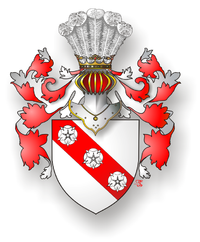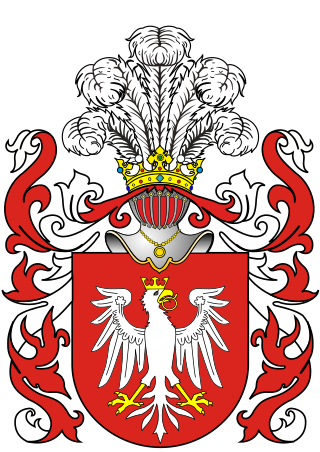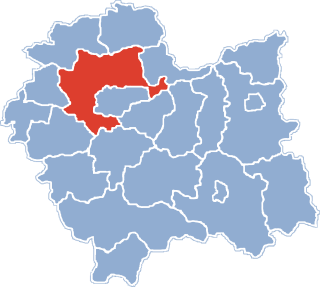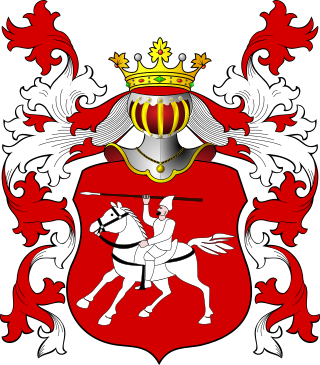This article includes a list of references, related reading, or external links, but its sources remain unclear because it lacks inline citations .(June 2010) |

Konderski is a Polish coat of arms.
This article includes a list of references, related reading, or external links, but its sources remain unclear because it lacks inline citations .(June 2010) |

Konderski is a Polish coat of arms.
Argent, a bend Gules, with three roses Argent.
The helm crowned with Polish nobleman crown. Crest out of a crown - five ostrich feathers.
Mantling Gules doubled Argent.
The coat of arms was granted at the coronation diet in 1764, for the Jewish brothers Joseph and Adam Konderski, former followers of Frankism. Confirmed by the Diet in 1775 and 14 June 1782.
Also the coat of arms of the related families of Kondek (Poland) and Konder (Saxon).
In heraldry, gules is the tincture with the colour red. It is one of the class of five dark tinctures called "colours", the others being azure (blue), sable (black), vert (green) and purpure (purple).

The coat of arms of Poland is a white, crowned eagle with a golden beak and talons, on a red background.

The coat of arms of the City of Wrocław is divided into quarters. It dates back to 1530, when it was approved by Emperor Charles V.

The coat of arms of Toronto, Ontario, Canada, was designed by Robert Watt, the Chief Herald of Canada at the time, for the City of Toronto after its amalgamation in 1998. The arms were granted by the Canadian Heraldic Authority on 11 January 1999.

Wąż is a Polish coat of arms. It was used by several szlachta (noble) families under the Polish–Lithuanian Commonwealth.

Poraj is a Polish Coat of Arms. Used by several knighthood families of medieval Poland and noble families of the Polish–Lithuanian Commonwealth - those descended in the male-line from the Poraj family and those allowed into the heraldic clan by adoption.

Ogończyk is a Polish coat of arms. It was used by several szlachta families in the times of the Kingdom of Poland and the Polish–Lithuanian Commonwealth.

Odrowąż is a Polish coat of arms of probably Moravian origin. It was used by many noble families known as szlachta in Polish in medieval Poland and later under the Polish–Lithuanian Commonwealth, branches of the original medieval Odrowążowie family as well as families connected with the Clan by adoption.

Amadej is a Polish coat of arms. It was used by several szlachta families in the times of the Kingdom of Poland and the Polish–Lithuanian Commonwealth.

Orla is a distinct Polish armorial estate and heraldic clan coat of arms adopted in Polish heraldry since the Crown of the Kingdom of Poland. It was vested upon several knightly families of Poland's nobility situated in the historical region of Greater Poland, Silesia and Lesser Poland from about the 14th century, where it was first historically known in Poland as the coat of arms of 'Saszor' [Szaszor], later 'Orla', and subsequently conferred on the ennoblement of several individuals.
In British heraldry, sable is the tincture equivalent to black. It is one of the five dark tinctures called colours.

The coat of arms of Luxembourg has its origins in the Middle Ages and was derived from the arms of the Duchy of Limburg, in modern-day Belgium and the Netherlands. In heraldic language, the arms are described as: Barry of ten Argent and Azure, a Lion rampant queue forchée Gules crowned, armed and langued Or.

The coat of arms of Denmark has a lesser and a greater version.

Kraków County is a unit of territorial administration and local government (powiat) in Lesser Poland Voivodeship, southern Poland. It came into being on January 1, 1999, as a result of the Polish local government reforms passed in 1998. Its administrative seat is the city of Kraków, although the city is not part of the county. The county contains five towns: Skawina, 12 km (7 mi) south-west of Kraków, Krzeszowice, 24 km (15 mi) west of Kraków, Słomniki, 24 km (15 mi) north-east of Kraków, Skała, 20 km (12 mi) north of Kraków, and Świątniki Górne, 15 km (9 mi) south of Kraków.

The coat of arms of Napoleonic Italy was the coat of arms used by the Kingdom of Italy (1805–1814) during the reign of Napoleon as King of Italy.

In heraldry and heraldic vexillology, a blazon is a formal description of a coat of arms, flag or similar emblem, from which the reader can reconstruct the appropriate image. The verb to blazon means to create such a description. The visual depiction of a coat of arms or flag has traditionally had considerable latitude in design, but a verbal blazon specifies the essentially distinctive elements. A coat of arms or flag is therefore primarily defined not by a picture but rather by the wording of its blazon. Blazon is also the specialized language in which a blazon is written, and, as a verb, the act of writing such a description. Blazonry is the art, craft or practice of creating a blazon. The language employed in blazonry has its own vocabulary, grammar and syntax, which becomes essential for comprehension when blazoning a complex coat of arms.

This article is about the coat of arms of the German state of Saarland.

Abgarowicz is a Polish coat of arms of Wallachian origin. Borne by several families of the Polish gentry during the times of the Polish–Lithuanian Commonwealth, it is most commonly associated with three clans of Armenian origin: the Abgarowicz, Wartanowicz and Zachariasiewicz.

Dąbrowski is a Polish coat of arms. It was used by several szlachta families.

The coats of arms of the Holy See and Vatican City in the form that combines two crossed keys and a tiara used as a coat of arms of the Holy See have origins attested from the 14th century. The combination of one gold and one silver key is a somewhat later development.